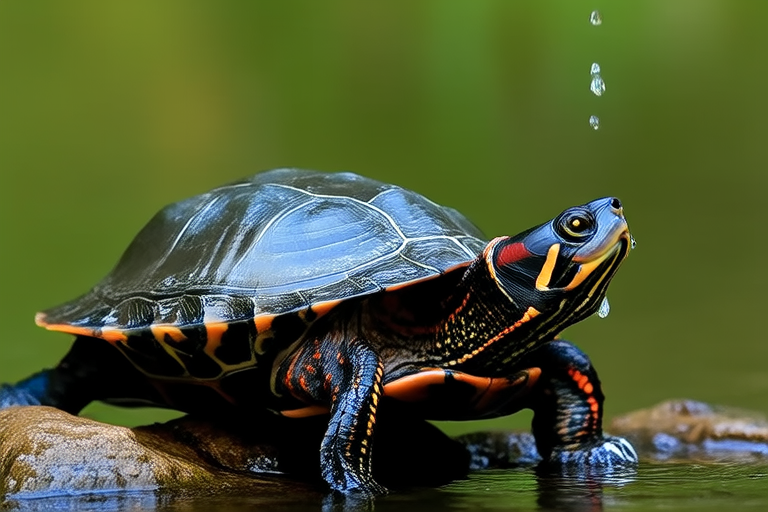
Red-Eared Slider: The Ultimate Beginner Turtle Guide
Welcome to your ultimate guide on caring for red-eared sliders! This comprehensive guide will help you understand everything you need to know about these fascinating reptiles. From setting up their habitat to understanding their dietary needs and health care, we’ve got you covered.
Choosing Your Red-Eared Slider
Selecting the right red-eared slider can be an exciting yet daunting task. When picking out your new pet, look for a healthy, active turtle. Avoid those with visible cuts or wounds, runny eyes or noses, or any signs of lethargy. Healthy red-eared sliders should have clear, bright eyes and a firm, symmetrical shell. It’s also wise to choose a turtle that is comfortable being handled, as this will make future interactions easier.
Habitat Setup
Creating a suitable habitat for your red-eared slider is crucial for their well-being. Start by choosing an appropriate tank size; for hatchlings, a 20-gallon tank is sufficient, but as they grow, you’ll need to upgrade to at least 40 gallons per turtle. Remember, larger tanks provide more space for swimming and basking, which are vital activities for your turtle.
The water area should be deep enough for swimming but shallow enough for easy access to the basking area. A good rule of thumb is to have a depth of twice the length of your turtle. For the substrate, opt for large pebbles or aquarium gravel that won’t be swallowed accidentally. Avoid small gravel or sand as it can cause impaction if ingested.
Your turtle will also need a dry, warm area for basking. Use a sturdy platform that allows them to climb out of the water easily. Ensure there’s enough space for them to stretch out fully. Position a heat lamp over the basking area to maintain a temperature between 85°F and 90°F (29°C to 32°C). A UVB light is also essential for vitamin D synthesis and overall health.
Water quality is critical for your turtle’s health. Invest in a reliable filtration system to keep the water clean. Regularly check the water parameters, including pH, ammonia, nitrite, and nitrate levels, to ensure they remain within safe ranges. Perform partial water changes weekly to maintain cleanliness.
Dietary Needs
Feeding your red-eared slider a balanced diet is key to their health and longevity. Their diet should consist mainly of commercial turtle pellets, supplemented with fresh vegetables like romaine lettuce, kale, and shredded carrots. Occasional treats of lean proteins such as earthworms, crickets, and cooked chicken can be offered sparingly. Feed your turtle daily, but only give them as much food as they can consume in 10-15 minutes to prevent overeating.
Ensure that the food provided is appropriate for their age. Young turtles require more protein than adults, while adult turtles benefit from a higher proportion of plant-based foods. Always cut or shred food into bite-sized pieces to prevent choking hazards.
Health Care
Maintaining good health for your red-eared slider involves regular monitoring and proactive care. Watch for signs of illness, such as lethargy, loss of appetite, swollen eyes, or unusual skin discoloration. If you notice any concerning symptoms, consult a veterinarian specializing in reptiles immediately.
Regular check-ups with a vet can help catch potential issues early. They may recommend routine blood tests, fecal exams, and X-rays to ensure your turtle remains healthy. Proper hygiene practices, such as frequent hand washing before handling your turtle, can prevent the spread of diseases.
Parasite control is another important aspect of health care. Consult your vet about the best methods for preventing and treating parasites in your turtle.
Common Behaviors
Understanding your red-eared slider’s behavior can enhance your bond and provide insights into their well-being. Turtles are generally solitary animals, so expect them to spend most of their time alone. They may exhibit curious behaviors when exploring their environment or interacting with new objects. Some common behaviors include basking, swimming, and occasionally digging in the substrate.
Basking is particularly important for your turtle’s health. It helps regulate their body temperature and promotes proper digestion. Encourage basking by providing a comfortable, warm spot in their habitat.
Red-eared sliders can be shy initially but will become more comfortable with regular gentle handling. Patience is key when building trust with your turtle.
Tips for Choosing Equipment
Investing in high-quality equipment ensures your red-eared slider thrives in its habitat. When selecting a tank, consider one made of glass or acrylic, as these materials resist scratches and are easier to clean. Look for a tank with a secure lid to prevent escapes. A filter is essential for maintaining water quality; choose one that matches the tank size and flow rate recommended by the manufacturer.
For heating and lighting, opt for products specifically designed for reptile habitats. These lights typically offer the correct spectrum of UVB light necessary for calcium absorption and overall health. Ensure the bulbs are compatible with your fixture and replace them according to the manufacturer’s recommendations.
Adequate substrates and decorations can enrich your turtle’s environment. Provide hiding spots and climbing structures to stimulate natural behaviors. Be cautious with live plants, as some may be harmful if ingested.
Conclusion
Caring for a red-eared slider can be incredibly rewarding once you understand their needs. By following this guide, you’ll be well-equipped to provide a loving home for your new turtle friend. Remember, patience and consistency are key to building a strong relationship with your pet. Enjoy watching your red-eared slider thrive in its new environment!





